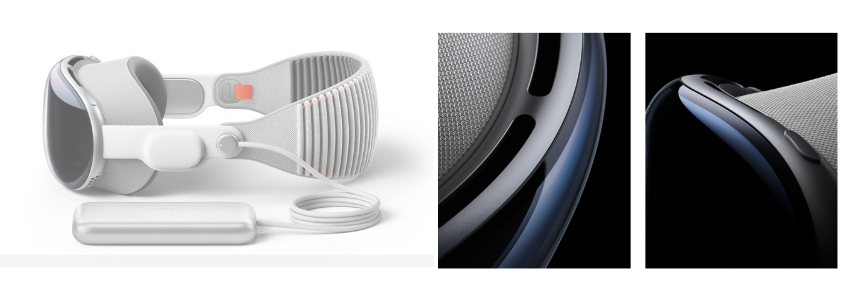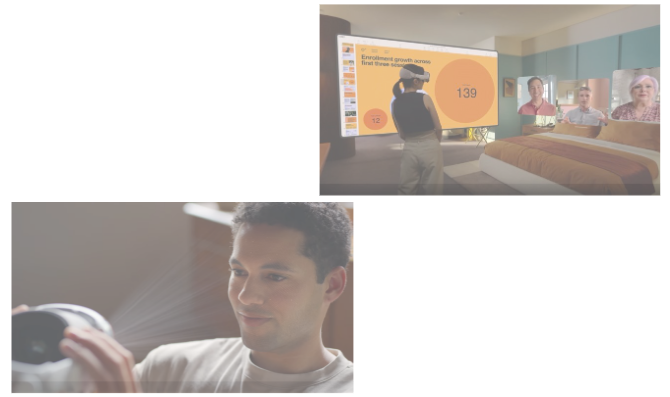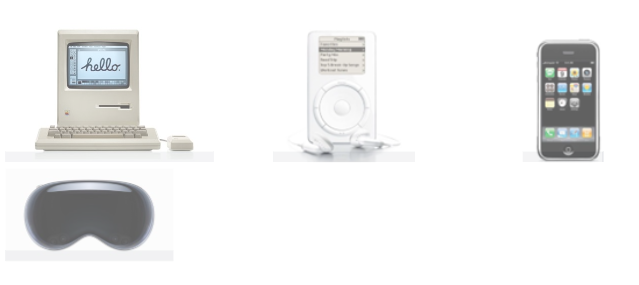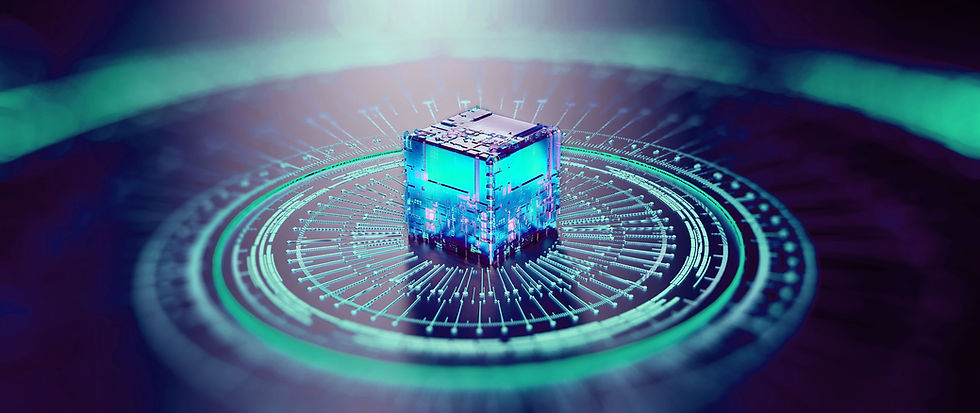Apple: Vision Pro
- Tomás Woods
- Sep 11, 2023
- 5 min read

The long-waited Apple VR headset has finally been released on June 6th 2023 and is set begin shipping at the start of next year. It has not only shown to be a feat of engineering to the eyes of the public as its functionalities have blown away all possible expectations. With two micro-OLED displays bringing 4k definition to each eye, 12 high-res cameras and a lidar-sensor, Vision Pro does real-time 3D
mapping to immerse viewers into a groundbreaking experience. This places Apple Vision Pro lightyears before any other VR technology in the world and it pushes the limits of simulation to a scary level. Here’s all you need to know about it and why it’s here to stay.
To begin with, this headset is one that greatly improves and works over functionalities provided by other VR sets in the market. This makes it a one-of-a-kind innovation that steps the industry up to another level of performance and capability. To start with, it has no hand controls or joy sticks. Everything the user needs to interact with and give input lies in their fingers. We can trace Apple’s UI lineup that started with the mouse for Macintosh, then touchscreen for iPhone and now, a 3D finger tracking technology. Finger gestures are captured through cameras around the headset and works even when your hand is resting on a surface. Once on, the headset’s internal cameras and infrared sensors will analyze your eye’s unique iris composition to unlock it with “Optic ID” enabling a quick and secure login. But wait, there’s more…
As one might expect, despite offering surreal functions, Apple has priced its Vision Pro at $3,499 which makes it unreachable to many. Nonetheless, for this value, the product is promising the most luxurious digital experience ever, and Apple has even partnered with Disney to develop magical cinematic experiences for entertainment. This might include watching a Star Wars movie while sitting on your favorite ship or seeing Mickey Mouse hopping around your room while you try to catch him. You can be travelling in a plane’s seat while actually feeling like you’re watching a 3D movie through the world’s largest Imax screen hovering above a lake. This is only possible thanks to Vision Pro’s two 23-million-pixel micro-OLED displays which combine to give an 8k viewing experience with screens the size of a postage stamp. In addition to viewing movies, users can now watch and fully interact with a 3D modeled basketball game floating above their dining table which they can replay from the comfort of their homes. The digital crown button on the top of the headset can be rolled to adjust how immersed you are into a digital 3D ambient and whenever the headset recognizes that someone is approaching, it merges the person’s body into the virtual world to let you know of the interaction. Furthermore, the headset features one speaker in each side that directs the sound to your ears without needing to touch it. With the help of its lidar sensor and cameras, it generates a 3D map of the room around you to create the best possible hearing experience based on the distance and vibrational properties of the objects which contributes the world’s most sophisticated computational audio experience. And that is just the tip of the iceberg. This VR set just opens a whole new world of possibilities to this new era of spatial computing and virtual reality.

At work, Apple Vision Pro is no short of amazing. It allows the user to connect with his laptop and Bluetooth assets and add how many displays they need and the size they want them to be. The dual-chip design of Vision Pro combines Apple’s M2 processor with its very own R1 chip, designed to manage sensors, cameras and displays, leaving M2 to work at its full potential. This makes it the most powerful VR headset ever built. Doctors can now evaluate complex 3D models of human organs and engineers can view rendered prototypes in scale to test capabilities prior to production. Thanks to R1’s processing capabilities, all real-time camera feed latencies are reduced to none, making the experience as natural as it can be. The displays give perfected sharpness to every point of the screen, thanks to a pixel density of 3,400 PPI (pixels per inch) which is more than 10x that of an iPhone SE. It also sustains an insane 5000 nits of brightness over daylight, or 3x better than that of an XDR display.

Vision Pro with virtual keyboard and screens. 3D file opened from messages.
At home, Vision Pro allows users to face-time their family members or have a conference while seeing every member of the call, face to face. The mechanism that Apple developed to make others see your face as if you weren’t wearing the headset is quite ingenious. When you first put it on, it will ask the user to face its front cameras so it can scan every part of your face with pinpoint accuracy. With this scan complete, its software will generate a bespoke avatar that looks almost exactly like you, with this being used as your face during videocalls. It will even use real-time camera feed of your lower face and eyes to adjust facial expressions that best match your face in present time. Moreover, given that people around you would not see your eyes and rather, a black piece of plastic over your face, Apple decided to address this aesthetic issue with a transparency hack. What appears to be see-through glass from the outside is actually an image generated by a second display that faces the outside of the headset. Once again, Vision Pro will use your 3D avatar and combine it with real time motion analysis to make it appear that your eyes are being seen through the displays, greatly improving real-life interactions. Portable. Ingenious. Complex. That’s what Apple has been able to create for the best possible experience with Vision Pro.

Virtual conference held in FaceTime. Face scanning for spatial personas.
The 1984 Apple Macintosh changed the computer industry forever. The iPod in 2001 changed the entire music industry. The iPhone reinvented the phone for decades to come, and now, Apple Vision-Pro brings a breakthrough to virtual reality and UI. Expect this product to change everything about technology, how we perceive it, how we use it and how we feel about it. Just as it can be used for making the best workflows and render previously unimagined solutions to global problems it can also create an unhealthy experience for users in an introverted society. Virtual reality should be taken rather seriously and used with conscience just as any other digital tool created by the tech industry, and hopefully, Vision Pro will too be used for great, enriching purposes.

1984: Macintosh 2001: iPod 2007: iPhone 2023: Vision-Pro
Sources (in MLA style):
Apple. "Apple Vision Pro." Apple, www.apple.com/apple-vision-pro/. Accessed 25 June 2023.
"Apple Vision Pro." Wikipedia, 25 June 2023, en.wikipedia.org/wiki/Apple_Vision_Pro#%3A~%3Atext%3DApple%2520Vision%2520Pro%2520has%2520a%2Csix%2520microphones%2520and%252012%2520cameras.
Ludus Global. "Apple Vision Pro: Features, Price, and Functions of the New Mixed Reality Glasses." Ludus Global Blog, www.ludusglobal.com/en/blog/apple-vision-pro-features-price-and-functions-of-the-new-mixed-reality-glasses. Accessed 25 June 2023.
“Apple Vision Pro Headset Questions Answered." Gear Patrol, 25 June 2023, www.gearpatrol.com/tech/a44054381/apple-vision-pro-headset-questions/#:~:text=The%2520Vision%2520Pro%2520has%2520built,a%2520Personalized%2520spatial%2520audio%2520experience.
"Vision Pro Optic ID Iris Scanning Could Be a Game Changer for Apple's New Mixed Reality Glasses." MacRumors, 5 June 2023, www.macrumors.com/2023/06/05/vision-pro-optic-id-iris-scanning/.






Comments